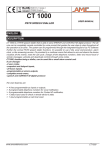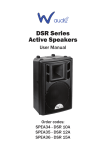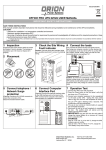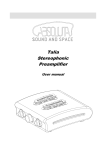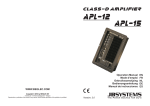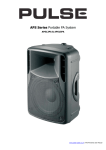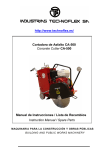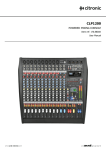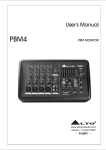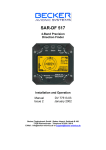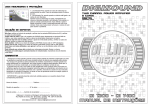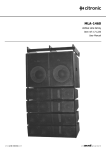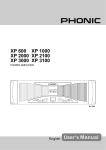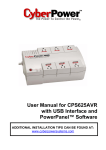Download Janus manuale uso inglese
Transcript
Janus Monoblock Power Amplifier User manual Important Safety Instructions 1. Read these instructions. 2. Save these instructions. 3. Pay attention to all advice. 4. Always follow instructions. 5. Do not use this unit in presence of water. 6. Clean with a dry cloth only. 7. Do not obstruct venting holes and heat sinks. Install as indicated by the manufacturer. 8. Do not install near heat sources as heaters, heat pumps, stoves or other equipment which produces heat. 9. Do not alter the functionality of a polarized plug or one provided with an earth connection. A plug is polarized when it can be fitted in the mains socket in only one way. A plug provided with earth connection has two prongs for current and a third one for earth connection. The latter is provided for user’s safety. If the plug provided doesn’t fit your mains socket consult your technician to obtain a replacement for the obsolete mains socket. 10. The mains cable represents the emergency detachment device for this unit. It is important to grant a quick access to this cable at any time. 11. Protect the mains cable against trampling and mashing, particularly close to the plug and to the connector at the input socket. 12. Only use connectors and accessories specified by the manufacturer. 13. Only use the cart, stand, tripod or table specified by the manufacturer or sold with the unit. When using a cart, pay attention while shifting the cart/unit ensemble to avoid harming people or flipping the cart upside down. 14. Isolate the unit from mains during lightning storms or when it’s not operated for extended periods of time. 15. Refer all servicing to qualified personnel. Servicing is required when the unit is damaged due to any reason, e.g. when mains cable or plug are damaged, when a liquid is spilled on it or when objects drop on the unit, when the unit is exposed to rain or moisture, or when the unit is not operative or has been dropped from whatever height. The replacement of the outer shell must be considered a service operation. 16. Venting must not be impeded by obstructing venting holes and heat sinks with objects like newspapers, towels, curtains and the like. 17. Do not place any free flame, like a candle or the like, on the unit. 18. Terminals marked with this label must be considered DANGEROUS and the connections external to these terminals require servicing by a TRAINED TECHNICIAN or the use of factory prepared cables. Warning! To reduce the risk of fire or electric shock, do not expose this unit to rain or moisture. Do not place objects containing liquids, like bowls or glasses, on this unit. 2 Warning! Changes or modifications not authorized by the manufacturer can invalidate the compliance to CE regulations and cause the unit not to be suitable for use any longer. The manufacturer rejects any responsibility regarding damages to people or things due to the use of a unit which has been subject to unauthorized modifications or due to misuse or to malfunction of a unit which has been subject to unauthorized modifications. 3 Instructions for Recycling The label on the left, printed on the envelope of the product, indicates that the product, when no more usable, can’t be treated as generic garbage, but must be disposed of at a collection point for recycling of electrical and electronic equipment, in compliance with the WEEE regulation (Waste of Electrical and Electronic Equipment). By making sure that this unit is correctly recycled, you will help preventing potential damages to environment and to human health. Recycling helps saving natural resources. For more in-depth information about recycling this product, please contact Absoluta Sound and Space Srl. ABSOLUTA SOUND AND SPACE Galleria Andrea Urbani, 3 35027 Noventa Padovana (PD) Ph. : Fax. Web: +39.049.8935377 +39.049.8935377 www.absoluta.it Customer Service Phone: +39.049.8935377 Fax: +39.049.8935377 e-mail: [email protected] P/N: 1234557 – Rev. 1.0 – 03/09 “Absoluta Sound and Space” and the logo Absoluta are registered trademarks of Absoluta Sound and Space Srl. © Absoluta Sound and Space Srl. All right reserved. This manual should not be construed as a commitment on the part of Absoluta Sound and Space Srl. The information it contains is subject to changes without notice. Absoluta Sound and Space assumes no responsibility for errors that may appear within this document. 4 Safety Terms and Symbols This document contains instructions on generic safety, installation and use for Janus monoblock power amplifier. It’s important to read this document before trying to use this amplifier. Pay particular attention to safety instructions. Appears on the unit to indicate the presence of uninsulated, dangerous voltages inside the enclosure - voltages sufficient to constitute a risk of shock. Appears on the unit to indicate important operation or maintenance instructions included in the accompanying documentation. Appears on the unit to indicate compliance with the EMC (Electromagnetic Compatibility) and LVD (Low-voltage Directive) standards of the European Union. Warning! Calls for attention to a procedure, practice condition, or the like that, if not correctly performed or adhered to, could result in personal injuries, death or damages to the unit or to other objects. Note Calls for attention to very important information. 5 This page has been intentionally left blank 6 Table of Contents Introduction .....................................................................9 Special Design Features...................................................9 Unpacking.......................................................................12 Installation Considerations..............................................13 Power Requirements ......................................................15 Operation.......................................................................17 Back Panel......................................................................17 Connections ....................................................................22 Base Connection Set-up .................................................24 Base Balanced Connection.............................................25 Passive Bi-amping Connection .......................................25 Bridge Connection ..........................................................26 Troubleshooting............................................................27 Maintenance ..................................................................27 Troubleshooting ..............................................................27 Maintenance ...................................................................30 Specifications................................................................31 Dimensions....................................................................33 7 This page has been intentionally left blank 8 Introduction Introdu ction Special Design Features Design Principles Dear Customer, thank you for purchasing Janus monoblock power amplifier. Janus combines the power and current delivery of a larger high performing amplifier with the small form factor. It delivers the great sound which only the best products can deliver and has an original and captivating look. Below you will find a description of all the features that make Janus a unique and valued product. Customizable external shell First class components Janus, like all Absoluta products, features an external removable shell, that can be easily replaced, to adapt the look of the amplifier to the furniture style and to better match the owner’s taste. The shell is available in various finishes and the customer can require custom versions, choosing amongst several materials and colors. Janus is made with first-class components, like the massive low stray flux and large bandwidth power transformer, the main reservoir capacitors with high capacity and low parasitic inductance, low tolerance polypropylene capacitors and special low noise resistors for audio use. The double layer printed circuit board is made with high thickness copper (105um in place of the usual 35um) to lower tracks resistance and inductance, particularly those which carry relevant current. The connections that carry the highest currents are made with suitable wires to reduce impedance to a minimum. This choice, together with the choice of using a massive copper bar as main ground connection for main reservoir capacitors, make for a very low impedance supply capable to support the needs of the high current circuit of the amplifier, up to the upper frequency limit and at full power. Current gain technology Absoluta has chosen to adopt the current gain technology for signal amplification chain, instead of the traditional voltage gain technology. The advantage of this choice are numerous and can be read within Janus specs: a very large power bandwidth (That is the frequency response measured when the amplifier is delivering Special Design Features – Design Principles (continued) 9 the rated power), a reduced rise time, capable to support the fastest transient at every listening level, and an intrinsic stability on every load. The large use of output devices (four 16A Sanken BJT for each polarity) and the robustness of the power amplifier granted by the 625VA transformer allow for an exemplar behavior of Janus with every loudspeaker, even with loudspeakers with impedances less than 2Ω. Actually, the output stage of Janus behaves as a real I-V converter, imposing to the load a faithful copy of the current signal amplified by the signal chain. The sophisticated input stage is made following the “diamond” topology, which allows for a high input impedance, absolute linearity and intrinsic V-I conversion with nearly infinite bandwidth and absence of any slew-rate effect. The input stage offers both single-ended and balanced inputs. In the case of the single-ended input both non-inverting and inverting nodes are accessible: it is then possible to choose the amplifier’s operation polarity following that of the preamplifier and of the loudspeaker. It is also possible to make a bridge connection of two Janus without using inverting circuits, to obtain a monoblock power amplifier capable of 450W on 8Ω. Janus is provided with an exclusive and refined electronic protection circuitry to grant the health of the output devices. Differently from most other products, Janus’ protection circuit is a sophisticated analog calculator that computes the Ic * Vce product, obtaining the instant power dissipated on each power transistor. With a bandwidth of 500kHz, the protection circuit constantly patrols the power transistor dissipation and only activates when it exceeds the borders of the dynamic S.O.AR. (Safe Operating ARea) for long. The collector current is monitored, too, to prevent it from exceeding its limit, no matter the power dissipated by the transistor The power capability of the output transistors is anyway such that protections activate only in unlikely limit conditions (shortcircuits on the output or strongly reactive loads with impedance module less than 1.5Ω). In the occurrence of continuous overloads, the protection circuit disconnects the load from the amplifier, to guarantee amplifier’s operation. The safety of the loudspeakers is guaranteed by a circuit which senses the offset (direct current) on the speakers output, disconnecting the load from the amplifier until the cause of the offset is removed. The same circuit immediately disconnects the load when an abnormal dynamic condition occurs (as happens, for 10 Special Design Features – Design Principles (continued) example, when an interconnect is inserted in the amplifier input when it is on). The circuit is also effective when a fault or a malfunction of the amplification circuit occurs. As further safety guarantee of the amplifier there is a specific circuit that senses the temperature of the heat sinks and disconnects the load (thus reducing the power dissipated by the output devices to a minimum) when their temperature rises too much. 11 Unpacking Warning! Failure to follow the procedures included in this section may result in personal injuries and/or product damage. DO NOT try to lift or move Janus without adequate assistance. Janus is a heavy and massive amplifier. Its weight is 14 kg (31 lbs.) without packaging, 28 kg (62 lbs.) with packaging. Don’t get fooled by its small size: its weight is enough to cause injuries to your spine, more so when it’s not possible to use a correct lifting technique. Two people are required to lift and shift Janus. Warning! DO NOT try to extract Janus from its packing without help. DO NOT try to lift Janus while bending on it. When lifting it, keep your back vertical as much as possible, using legs to lift the amplifier. When extracting Janus from its packing: ● DO save all packaging materials for possible future shipping needs. ● Do inspect Janus for signs of damage that may have occurred during shipment. If damage is discovered, contact an Absoluta authorized dealer for assistance making appropriate claims. 12 Installation Considerations Janus requires special care during installation to ensure optimal performance. Pay particular attention to the precautions included in this section and to other precautions included throughout this owner’s manual. Placement ● DO review “Important Safety Instructions” and “Power Requirements” before installing Janus. ● Do place Janus on a solid, flat, level surface, such as a table, a shelf or the floor. ● DO position Janus closet to the associated loudspeakers in order to keep loudspeakers wires as short as possible. Use longer interconnect cables between Janus and the preamplifier. This is preferable because interconnect cables pass lowvoltage signals, which transmit over distances with greater accuracy than the high-voltage signals required by loudspeakers. ● DO allow at least 15cm clearance behind Janus for the power cord and other cables to bend without crimping or straining. ● DO see “Dimensions” for assistance with custom installation. ● DO NOT position Janus near low-level components. This amplifier is capable of producing massive output currents which could generate significant magnetic fields that induce noise in some sensitive components. ● DO NOT place Janus on a windowsill or in another location in which it will be exposed to direct sunlight. Solar radiations can damage the external shell and alter its color. Warning! BEFORE moving Janus, make sure it is powered off using the power cocker switch on the back panel. Then, make sure that the power cord is disconnected from the AC mains connector and from the power outlet. DO NOT attempt to move Janus without adequate assistance. Proper lifting requires at least two people. Ventilation Janus dissipates the heat produced during operation through two massive heat sinks placed laterally to the cabinet, and thanks to several venting holes located on the bottom of the cabinet, and on the top cover. Hot air coming out of these holes finds its way thanks to a particular design of the external shell. Installation Consideration (continued) 13 When Janus is placed in a position in which a correct air flow is provided, its proper operation is ensured at every listening level and with every loudspeaker. Due to the high bias of output devices, Janus produces relevant heat even in idle. Heat sinks can become very hot during high volume listening. Please consider that a temperature of 60°C makes the heat sinks impossible to touch with bare hands. Thermal protection triggers when heat sinks’ temperature reaches 85°C. ● DO select a dry, well-ventilated position, out of direct sunlight. ● DO NOT obstruct venting holes in the bottom and on top of the cabinet or on the outer shell. Do not reduce air flow through the cabinet and around Janus’ heat sinks. ● DO NOT place Janus on a thick carpet. Do not cover it with a cloth, as this would prevent proper cooling. If Janus is placed on the floor, use a thick tempered glass sheet to provide a stable base and to provide adequate venting. ● DO NOT expose Janus to high temperature, humidity, steam, smoke, dampness or excessive dust. Avoid installing Janus near radiators and other heat-producing appliances. 14 Power Requirements Janus is configured to operate at the voltage present in the Country where it is sold. Before activating Janus, make sure that the label on the back panel indicates the right mains voltage. Warning! DO NOT attempt to adjust the operating voltage. If the operating voltage is incorrect or if the operating voltage must be changed for relocation purposes consult an authorized Absoluta dealer. BE ADVISED that different operating voltages may require the use of different power cords and/or attachment plugs. Contact an authorized Absoluta dealer for assistance. Janus is capable of passing remarkable musical signals regardless of signal and loudspeakers demands. On either an instantaneous or continuous basis, this amplifier is capable of driving exceptional power level into most of loudspeakers loads. Depending on listening habits, on loudspeakers demands and on the number of power amplifiers present in the system – it is possible for the electrical service to become the limiting performance factor. In this case, consider installing a dedicated AC circuit for the home entertainment system. Contact a licensed electrician for assistance. If more than one electric circuit is providing power to the system, contact a licensed electrician to ensure that all components are operating with the same, solid low-impedance round reference. Note Warm-up & break-in period Building regulations and electrical codes differ from location to location, making it impossible to anticipate the requirements of high-current AC circuits such as Janus is capable of using. Contact a local, licensed electrician for information. Although Janus delivers superior performance from the first time it’s powered on, this performance will continue to improve as the power amplifier reaches its normal operating temperature and various components “break-in”. The greatest performance improvements will occur within the first 100 hours of use. Sound quality will continue to improve for about 300 hours. After this initial period, Janus’ performance will remain consistent unless the unit is switched off. Once switched off, after the successive switch-on nearly half an hour will occur before Janus will give its best performance again. 15 Power Requirements (continued) Operating modes Janus has three operating modes: 1. Off Power is considered disconnected from Janus (back panel Switch on “0” and trigger input not connected or power cord disconnected). 2. Standby The back panel switch is on “0”, the power cord is connected to the power outlet and the trigger input is connected to the trigger output of another device, but it’s not active. Janus is not operative but can be switched on activating the trigger output of the device to which Janus trigger input is connected. 3. On The power cord is connected to the mains outlet and the back Panel switch is on “1” and/or the trigger input is driven (active) by the trigger output of another device. Note Continuous operation Janus is designed to operate with a high bias on the output stage, for this reason it generates relevant heat even when idle. Idle power consumption is 30W, which are dissipated as heat. Janus should be unplugged from the mains outlet during lightning storms and extended periods of non-use. Otherwise, it is designed for continuous operation. Although Janus performance reaches its best after half an hour of operation, it is better not to keep the unit continuously on in order to have the best sound always available. This would cause an unnecessary waste of electrical power. Janus would be exposed to unnecessary risks and some fundamental components would be subject to fast ageing. 16 Operation Back Panel The numbers in the back panel illustration shown above correspond to the items in this section. 1. Non-inverting single-ended input connector Non inverting unbalanced audio input. An RCA socket accepts single-ended signals from a preamplifier. Signal phase is maintained from Janus input to output when using this connection. To minimize noise pick-up, it’s better to short-circuit this connector with a shorting plug when using the inverting single-ended input connector. 2. Inverting single-ended input connector Inverting unbalanced audio input. An RCA socket accepts single-ended signals from a preamplifier. Signal phase is inverted from Janus input to output when using this connection. To minimize noise pick-up, 17 Back Panel (continued) it’s better to short-circuit this connector with a shorting plug when using the non-inverting single-ended input connector. 3. Balanced input connector G + Balanced audio input. An XLR female connector accepts balanced signals from a preamplifier. Janus offers highest level performance no matter what connection is used. Whenever the distance between Janus and the preamplifier is relevant (more than 5 meters or 15 feet) and/or whenever remarkable EMI disturbances are present in the room, the balanced connection provides superior rejection to electromagnetic interferences (EMI). - Note When using the balanced input, the shorting plugs MUST be removed from the two single-ended input connectors. Note Pay attention to the layout of hot and cold poles (“send” e “return”) in the balanced output connector of the preamplifier used with Janus. Two standards can be found, one used in Japan and, sometimes, in USA; the other used in Europe and, often in USA. The two standards differ in which hot and cold poles are exchanged in the connectors. Absoluta products comply to European standards. Should your preamplifier adhere to the Japanese standards, a phase reversal results from connecting the preamplifier to Janus, one which can be recovered by inverting speakers cable polarity at Janus output posts. 4. Positive output post Power output positive post. A gold plated connector accepts bare wire, bananas and spades lugs. Thanks to the presence of an axial hole it is possible to simultaneously connect two cables, one of which terminates with bananas, to implement a bi-wiring connection of the loudspeakers. The connector’s large size makes for best current transfer from amplifier to loudspeaker. Warning! NEVER connect the positive power output to any component other than a loudspeaker NEVER short-circuit the positive output to the negative one or with any metal part of the amplifier. 5. Negative output post Power output positive post. A gold plated connector 18 Back Panel (continued) accepts bare wire, bananas and spades lugs. Thanks to the presence of an axial hole it is possible to simultaneously connect two cables, one of which terminates with bananas, to implement bi-wiring connections of the loudspeakers. The large size of the connector makes for best current transfer from amplifier to loudspeaker. For best performance, use high-quality loudspeakers cable. To connect these cables, use high quality termination, soldered or accurately crimped at cable’s ends. ● Connect Janus positive output post to the loudspeaker’s positive input. This input is generally associated with red color. ● Connect Janus negative output post to the loudspeaker’s negative input. This input is generally associated with black color. Warning! DO NOT OVER-TIGHTEN the binding posts. The specific contact surfaces allow for a good contact even when the posts are tightened by hand. No specific tool is required to increase the tightening. Whenever a better contact is required, please us expansion banana connectors. DO NOT FORCE the posts to help the insertion of a connector of a size or shape that doesn’t fit the post: posts way be damaged. 6. Trigger output connector 3,5mm jack socket for trigger output. A 12V DC voltage is available on this output when Janus is on. Using this output it is possible to activate another component provided with a Trigger input. For example, in a system in which two Janus are used, one can be activated by the other by connecting the trigger output of the first one to the trigger input of the second one. + - As the voltage is available on the trigger output after some seconds from Janus activation, using the trigger to activate the second amplifier avoids that switch-on surges of the two units have place at the same time, reducing the risk for the mains protection to trigger The trigger output is protected against short-circuits and overloads by a polyswitch fuse. It’s always better to check 19 Back Panel (continued) the polarity of the connection and not to overload the output. Please refer to technical specs to find out the maximum output current delivered by this output. 7. Trigger input connector 3,5mm jack socket for trigger input. By applying a 12V DC voltage to this socket Janus is activated, no matter the state of the power main switch. The trigger input and the main power switch are in parallel, thus the trigger input is not operative when the main power switch in on “1” ( it’s not possible to switch the amplifier off but triggering the main power switch) Connect Janus trigger input to the trigger output of a Preamplifier or of another Janus. Warning! PAY ATTENTION to the polarity of the voltage applied to the trigger input: it’s protected against polarity inversions, but the trigger output of the driving unit could be damaged. 8. Main power switch Switches Janus on ( “1” position) and off ( “0” position) when the power cord is connected to a power outlet and the trigger input is not active (in this case the amplifier is always on regardless of the switch’s state. Note The main power switch must be in “0” position (off) for the trigger input to be operative. 9. Fuse holder Contains the main power fuse. Internal circuits are already protected by other fuses located on the printed circuit board. The fuse container in this fuse holder only burns after critical Events (huge amplifiers faults). Should this happen, disconnect the power cord from the outlet and contact an authorized Absoluta dealer for assistance immedialtely. Warning! Warning! DO NOT try to replace the fuse. Potentially dangerous voltages and relevant charge are present inside Janus even when the amplifier is off. DO NOT try to open the amplifier’s cabinet to try servicing. 20 Back Panel (continued) Refer all servicing to your authorized Absoluta dealer. 10. Mains socket Provides main supply to Janus when the power cord provided with the amplifier is connected to it. Note Warning! Before switching Janus on, make sure that the label on the back panel showing the operating voltage is indicating the right voltage. Janus has been designed and tested to be used with a power cord provided with earth wire and with a three prong plug. Do not damage or detach the earth prong from the power cord plug. 21 Connections Janus offers numerous options for connection to preamplifiers and to loudspeakers. Absolute phase The absolute phase of the signal (e.g. the relationship between the phase of the incoming signal from the preamplifier and that of the signal applied to the loudspeaker) can either be maintained or inverted depending on the input used and on the polarity with which the loudspeakers are connected to the amplifier’s output. When using the non-inverting single-ended input or the balanced input (european standard), absolute phase is maintained by connecting the positive input of the loudspeakers (red) to the positive output post of the amplifier and by connecting the negative input of the loudspeakers (black) to the amplifier’s negative output. By inverting this connection, absolute phase is inverted, too (that is, your system becomes inverting). Note Bi-wiring When using the inverting single-ended input or when driving the balanced input with a preamplifier whose balanced outputs comply with the Japanese standard, Janus becomes inverting. In this case the absolute phase has to be restored by exchanging the cable connections of the speakers either at amplifier’s outputs or at loudspeaker’s inputs only. The availability of an inverting input on Janus is useful when using an inverting preamplifier (as many tube preamplifiers are) because it allows for restoring absolute phase by introducing a second phase inversion in the power amplifier. Many loudspeakers give better performance when driver in biwiring. This technique requires the use of a pair of cables to drive the low frequency section of the loudspeaker and another pair of cables to drive their mid-high section. To implement this technique it is necessary that the speaker is provided with two pair of binding posts. As Janus is provided with a single pair of output binding posts, it is necessary to connect two cables to each post. It is advisable to choose cable terminations which don’t apply excessive strain to the amplifier’s posts. A good choice could be using bananas for one cable pair and spades for the other, such as to use both connection modes offered by the posts. Attenzione! Even if it’s possible to connect bare wires to the posts, it is better not to choose this solution: chances are that some 22 Connections (continued) conductors escape the tightening and accidentally contact the metal parts of the amplifier or other conductors from the other polarity cable, causing short-circuits. Attenzione! Bridging Collegamento a ponte (bridging) ALWAYS PREFERE cables provided with suitable terminations. When a higher power than that provided by a single Janus is necessary, It’s possible to connect two Janus in bridge mode, obtaining an amplifier capable of 450Wrms continuous @ 8Ω and 900Wrms continuous @ 4Ω. Connect the two Janus as follows: ● Connect the non-inverting input of the first Janus to the preamplifier’s output. ● Connect the inverting input of the second Janus to the same Output of the preamplifier (a suitable splitter must be used) or to a second output of the preamplifier on which the same signal as the first output is present. ● Connect the positive input of the speaker to the positive output of the first Janus. ● Connect the negative input of the speaker to the positive output of the second Janus. ● Connect the two negative output posts of the two Janus each other. Note It’s preferable, even if not mandatory, to switch the amplifiers on that when using the trigger feature, the two bridged Janus be driver in parallel by the same trigger output, to switch them together. Nota If, by mistake, the same input (non-inverting or inverting) is used on both Janus, they will operate with the same phase and the resulting signal on the loudspeakers posts will be virtually zero. This should cause no harm to either the loudspeaker and the amplifiers. Nota Warning! Attenzione! DO NOT use loudspeakers with impedance less than 4Ω with bridged Janus: in this set-up each Janus “sees” a load with impedance equal to half of the loudspeaker’s impedance and it’s required to supply twice as much the current it delivers when operating “alone”. This translates 23 Connections (continued) into a greater load on the output stage and could lead to protection activation with the music climaxes. Base Connection Set-up The basic Janus connection configuration requires using two Janus, one per channel, and a preamplifier (for example, Talia). Connect the non-inverting input of each Janus to one of the pre outputs of the preamplifier, one to the Left output and one to the right output using shielded cables with RCA termination. Connect the cables from each loudspeaker to the power output of each Janus, paying attention to the polarity. If the trigger function is to be used, and when the preamplifier is provided with a suitable output on a 3.5mm jack socket, connect the preamplifier’s trigger output to the trigger input of one Janus using a interconnect provided with 3.5mm jacks (mono or stereo). Then, connect the trigger input of the other Janus to the trigger output of the first Janus using another interconnect provided with 3.5mm jacks. Note To use Janus in inverting mode, connect the preamplifier output to Janus inverting input. Note Short the unused input connector with the shorting plug provided with the amplifier. This reduces noise pick-up from the unused input to a minimum. 24 Base Balanced Connection When the preamplifier is provided with balanced outputs with XLR connections, it is possible to connect it to Janus in balanced mode using balanced cables with XLR plugs. This connection options is to be preferred when the power amplifiers are far from the preamplifiers (more than 5m or 15ft) and/or when the system is located in a room in which strong electromagnetic disturbances are present. Note When using the balanced connection, the two single-ended input connectors (RCA) must be left open. Note Depending on the standard of the preamplifier’s output XLR connectors (European or Japanese), the signal’s phase may result inverted at the input terminals of the loudspeakers. In this case, it’s possible to restore the absolute phase by inverting the connection of the speakers cables at the amplifiers or loudspeakers posts only or using the phase switch of the preamplifier, when available. Passive Bi-amping Connection When the loudspeakers are provided with separate inputs for low frequency and high frequency drivers, it is possible to implement a passive bi-amping connection. This connection mode requires two Janus per channel, driven by the same output connector of the preamplifier (Left or Right) by a suitable 25 splitter, or by two different Left or Right outputs if they are available. It is possible to make both single-ended connections (using coax cable and RCA connectors) and balanced connections (using balanced cable and XLR connectors). Please refer to the previous indications for the specific connections. Bridge Connection When speakers’ sensitivity and/or the size of the listening room call for a higher output power than that delivered by a single Janus pair, it is possible to use four Janus connecting them in pair in bridged mode. This set-up allows for three times as much power as a single pair of Janus, with a net gain of 5dB SPL. By using eight Janus is then possible to make a passive biamping bridged configuration, following these indication together with the previous ones (“Passive Bi-amping Connection”). 26 Troubleshooting Maintenance Troubleshooting A wrong use is sometimes mistaken for malfunction. Should problems occur, refer to this section. If problems persist, contact your authorized Absoluta dealer. 1. The amplifier does not turn on (turn-on is indicated, a few seconds after activation, by a “click” from the internal output rele). ● Check for mains power cord correct insertion in the Janus mains socket. ● Check for mains power cord’s plug correct insertion in the mains outlet. ● Check for power cord integrity. ● Make sure that the main power switch is on “1” or that the trigger input is driven with a 12 V DC voltage with the correct polarity. ● Check for mains fuse integrity. ● It is possible that one of the internal fuse is s blown. In this case, disconnect the unit from the power outlet and contact your authorized Absoluta dealer. DO NOT try to replace any fuse nor any other serviceable part inside the unit. Warning! Potentially dangerous voltages are present inside Janus, even when the unit is off. DO NOT try any servicing inside the unit. DO NOT open unit. Contact your authorized Absoluta dealer for servicing. 2. The amplifier turns on (turn-on is indicated, a few seconds after activation, by a “click” from the internal rele) but no sound comes from the loudspeaker. ● Make sure that loudspeakers cables are correctly connected to Troubleshooting (continued) 27 to Janus output posts. ● Make sure that the interconnect cable is correctly connected to Janus input and to preamplifier output. ● Make sure that the preamplifier is on. ● Check for integrity of all interconnect and power cables used with Janus. ● It is possible that Janus goes into protection right after activation due to a short-circuit on the output of the speaker. It is possible to verify this by carefully listening the relay “click”: if a second click is heard right after the first one, chances are that the protection circuit of the amplifier has sensed a short-circuit on amplifiers output: remove the short-circuit. When discovering that one of the cables (interconnect or power) is not correctly connected, switch Janus off before completing the connection. NEVER connect or disconnect a cable when Janus is on! This could result in amplifier or loudspeaker damage. 3. The output rele disengages every time the preamplifier is turned on or when a certain source is selected, to reengage after a few seconds. ● DC offset is present on preamplifier or on source output. Janus is able to null this offset, but the presence of DC offset at the amplifier input may result in a reduction of the quality of the saound and inJanus excessive heating. Contact the dealer who sold the preamplifier or the source for servicing. 4. The amplifier doesn’t turn on by the trigger input. ● Check for correct connection and polarity of the cable between the trigger output of the preamplifier and Janus trigger input. 5. The voltage at the Janus trigger output doesn’t reach the component to which the output is connected. ● Check for integrity of the cable used to take the trigger voltage from Janus to the component input. 28 ● Check for magnitude and polarity of the voltage required to activate the component to be activated by Janus. Troubleshooting (continued) 6. The sound produced by Janus is distorted at high levels. ● The loudspeaker used with Janus and/or size and listening room absorption require more power than that delivered by Janus. Use two Janus in bridge set-up on each channel or try bi-amping. 7. Janus overheats and/or thermal protections engage frequently. ● The unit is not properly ventilated or it’s placed in an excessively hot room. Allow for more free room around, over and under the unit to increase ventilation and/or move it to a cooler place. ● The unit is constantly overdriven on a very difficult load. Reduce listening level or add a second Janus (in bridge or bi-amp set-up) ● A relevant DC offset is present on Janus input (see item 3 to solve this problem). ● The unit is damaged. Switch Janus off and contact your authorized Absoluta dealer. 8. A light electric shock is perceived when touching the exposed metal parts of Janus when it is connected to the mains. ● Janus earth connection is faulty. Switch the unit off, disconnect it from mains and contact your authorized Absoluta dealer. ● Your house mains network is not provided with safety earth, or the mains outlet you’re using is not provided with earth connection. Contact a licensed electrician to solve this problem. Warning! DO NOT, for any reason, disconnect or eliminate the earth connection of mains outlet, power distributors of power cords! Janus has been designed to provide top performance and safety with a earth connection. Using the unit without an adequate earth connection may result in damage to the unit or to other components connected to it and severely harm or cause the death of whoever gets in touch with the metal parts of the unit! 29 Troubleshooting (continued) In all other cases not covered by this section, switch unit off and disconnect from mains outlet and from all other components of the system. Contact your authorized Absoluta dealer for assistance. Maintenance Janus has been designed to give his owner years of trouble-free use. The unit doesn’t require any maintenance on a regular basis, nor does it require adjustments of any kind. The only maintenance operation to be done on a regular basis is the one needed by outer shell, to remove dust and fingerprints. Failing to follow the indications in this section may result in damages to the unit and warranty voiding. Nota ● Use a feather duster or a low pressure blower to remove dust from Janus surface and heat sinks. ● Use a soft, lint-free cloth to remove dirt and fingerprints from Janus exterior surface. DO NOT use a cloth made with steel wool or metal polish. ● When needed, the cloth can be dampened with isopropyl alcohol to clean metal parts. DO NOT use acetone, benzene and other commercial cleaners. ● The outer shell must be treated, depending on the material it’s made of and on its finish, with the cleaner recommended by the manufacturer (the indication is given together with the shell, on a separate sheet). Warning! DO NOT drop or apply liquids directly onto the unit, because this could damage the internal components and prevent the unit from operating properly. Nota 30 Specifications Rated Output Power ● 150Wrms @ 8Ω ● 300Wrms @ 4Ω ● 550Wrms @ 2Ω All rated power values are 10Hz to 200kHz, with a THD less than 0.1% e at nominal mains voltage. Any load phase. Measured Ouput Power ● 176Wrms @ 8Ω ● 330Wrms @ 4Ω Power measured @ 1kHz, on resistive load, with THD less than 0.1% at nominal mains voltage. Peak Current Frequency Response Signal-to-Noise Ratio THD + N Input Impedance ● 64A (10ms) ● 20Hz to 20kHz +/-0,1dB ● 10Hz to 250kHz +/-3dB ● 85dB not weighted ● 88dB “A” weighted (ref. nominal output voltage) 0.04% (@ 2.83Vrms output) ● 47kΩ (unbalanced) ● 100kΩ (balanced) Gain Sensitivity ● 26dB ● 1.73Vrms for rated output power 31 Specifications (continued) Power Consumption ● 625VA (+/-5%) max. output power ● 30VA (+/-5%) idle Mains Voltage Size Weigth ● Fixed as indicated by the label on the back panel ● 270 x 144.5 x 429.8 mm (see “Dimensions”) ● With packing: 28kg ● Net: 14kg Connectors ● 2 gold plated output binding posts for loudspeaker ● 2 gold plated RCA input connectors ● 1 female XLR balanced input connector ● 2 mini-jack (3,5mm) connectors for triggers ● 1 IEC mains socket 32 Dimensions s Dimension 33


































